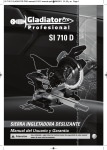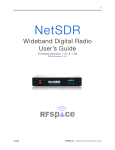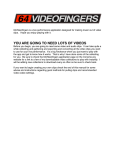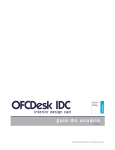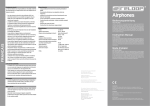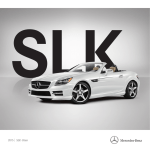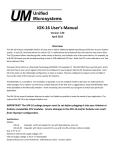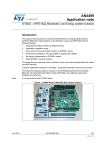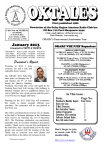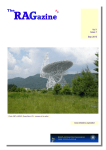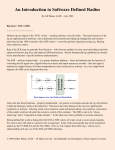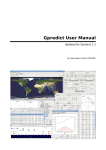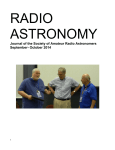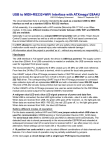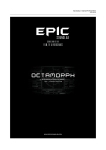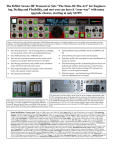Download User Guide
Transcript
Software Defined Radio in Max/MSP A software defined radio receiver. Works with the Soft66lc2 (500 KHz to 30 MHz) and the FUNCubeDongle Pro (64 MHz to 1.7 GHz) Features include: • • • • • • • • Support for generic IQ devices and files SSB, AM, FM, and FMW AGC, Notch/Peak filter, and Noise filters Midi control-surface support iPad control-surface support via touchOSC Memory store/recall Scanner interface Synthesizer interface Runs in Mac OS and Windows Requires Max/MSP 5+ (distributed by Cycling74) (iPad screens require touchOSC app) For downloads, support, and tutorials: http://zerokidz.com/radio Figure 1 - A software defined radio receiver in Max/MSP Credits: This project is derived from the work of the following developers: • • • • • • • • Kazunori Miura, JA7TDO - Soft66lc2 hardware/software design Thomas Horsten - Linux soft66add control software Thomas Robin-Couerrier - PPC externals, conversion & testing Howard Long, G6LVB - FUNCube hardware/software design Alexandru Csete, OZ9AEC - QTHid FUNCube control software Mario Lorenz, DL5MLO - FUNCube control software David Pello, EA1IDZ - Linux FUNCube command line control software. Joseph Zicarelli, KB1URI - Project design and testing. Thank you. Tom Zicarelli, KA1IS - November 19, 2011 Table of Contents Software Defined Radio in Max/MSP ................................................................................ 1 Credits:............................................................................................................................ 2 System Design .................................................................................................................... 5 User Interface.............................................................................................................. 7 Software Design................................................................................................................ 11 Software Design................................................................................................................ 11 Source code ................................................................................................................... 11 Software Signal Path..................................................................................................... 12 Audio Input Menu..................................................................................................... 12 Device/File Menu...................................................................................................... 12 IQ flip........................................................................................................................ 13 IQ balancer................................................................................................................ 13 preamp/attenuator/RF gain control ........................................................................... 13 Bandscope and tuning controls ................................................................................. 13 Mode select control................................................................................................... 13 Mixer......................................................................................................................... 14 Lowpass filter............................................................................................................ 14 AGC .......................................................................................................................... 15 Detector (demodulator)............................................................................................. 15 Audio Notch/Peak filters........................................................................................... 16 Hum filter.................................................................................................................. 16 Noise filter ................................................................................................................ 16 Lowpass filter............................................................................................................ 17 Device control............................................................................................................... 17 Soft66lc2 ................................................................................................................... 17 FUNCube .................................................................................................................. 17 MIDI control ............................................................................................................. 17 User Manual...................................................................................................................... 19 Installation..................................................................................................................... 19 Hardware Setup............................................................................................................. 19 Cables........................................................................................................................ 19 Antennas ................................................................................................................... 20 Audio......................................................................................................................... 20 Using the program......................................................................................................... 20 Sliders, buttons, and toggles ..................................................................................... 20 Audio/MIDI setup..................................................................................................... 21 Basic operation.......................................................................................................... 22 Audio on/off.............................................................................................................. 23 Memory presets......................................................................................................... 23 Controlling Device Frequency.................................................................................. 24 Filters ........................................................................................................................ 24 Tuning tips and troubleshooting ............................................................................... 24 AGC .......................................................................................................................... 25 Scanner...................................................................................................................... 25 Midi Specification......................................................................................................... 27 Midi feedback ........................................................................................................... 29 iPad Interface ................................................................................................................ 29 Synthesizer interface ..................................................................................................... 31 [led] display screen ....................................................................................................... 31 What’s Next? ................................................................................................................ 32 References..................................................................................................................... 32 Antennas ....................................................................................................................... 32 Complex numbers and modulation ............................................................................... 33 CuteSDR ....................................................................................................................... 33 Digital signal processing............................................................................................... 33 FUNCube ...................................................................................................................... 33 GNURadio companion.................................................................................................. 34 IQ data files................................................................................................................... 34 PebbleSDR.................................................................................................................... 34 Soft66lc2 ....................................................................................................................... 34 Software defined radio.................................................................................................. 34 System Design In a software defined radio system (SDR), components traditionally built with hardware, are implemented in software using digital signal processing (DSP). Familiar products like cell phones and wireless routers are examples of SDR’s. The project described here is a software defined radio receiver with three physical components: • • • Antenna RF front-end computer antenna RF front end: bandPassFilter LO mixer USB Device control Baseband IQ signal to soundcard Computer: DSP & device control audio output In a direct conversion SDR, the RF front end sends input signals through a bandpass filter to a mixer which shifts the frequency down into the audio spectrum. The mixer uses two local oscillator (LO) signals that are 90 degrees out of phase to produce “I” and “Q” signals (in-phase and quadrature). IQ signals are also referred to as complex or analytic signals. Using IQ signals simplifies frequency shifting and demodulation. Figure 2 - IQ modulator The computer reads baseband IQ signals, via the sound card, and converts them to digital data (ADC). The rest of the processing happens in software. This includes mixing, filtering and demodulation. The final result is converted to analog audio by the sound card (DAC). Typically an SDR program also sets device frequency and selects appropriate hardware filters via a serial (USB) interface. The RF front-end devices used in this project were selected based on cost and frequency coverage. The Soft66LC2, designed by Kazunori Miura, JA7TDO, costs $108 USD and covers 500 KHz to 30 MHz. Figure 3 - The Soft66lc2 The FUNcubeDongle Pro (FUNCube), designed by Howard Long, G6LVB, costs $186 USD and covers 64 MHz to 1700 MHz. Figure 4 - The FUNCubeDongle Pro This project was developed in Max/MSP 5 (Max), from Cycling74 on an Apple Macbook (OS 10.6). Max provides a wealth of audio DSP objects which are easily adapted to the signal processing requirements of SDR Max external objects for device control are written in C. They are compiled using Xcode 4 for the Mac and Visual Studio C++ Express for Windows. Figure 5 - A Max patch User Interface The radio interface is designed to fit a small screen while still providing access to the underlying processing blocks. Like most SDR applications, the goal is to make it look and feel like a hardware radio. In addition to the standard Max user interface (UI) objects the receiver supports remote operation via Midi and the iPad (running touchOSC). Max has an extensive library of MIDI interface objects. This makes it possible to use control surface hardware with real knobs and buttons to operate the radio. A complete MIDI specification is included in the appendix. It has been tested with the Behringer BCR2000 but any programmable Midi device can be used to control and receive feedback from the radio. Figure 6 - BCR2000 Midi control surface Remote iPad operation is accomplished using the touchOSC and Airphones apps. touchOSC sends and receives data using the Open Sound Control (OSC) protocol. Here are examples of the iPad radio screens: Figure 7 - iPad radio screen Figure 8 - iPad scanner screen Figure 9 - iPad synthesizer screen touchOSC communicates with Max via Wifi. Max sends audio back to the iPad via Wifi using the Airphones App. This allows the iPad to be used as a self contained remote receiver – using the laptop as a server for the radio hardware. An alternative user interface display using Max [led] objects is shown below Figure 10 - [led] display screen Software Design Max uses a visual design paradigm featuring object boxes and patch cords. A Max patch looks a lot like a circuit schematic diagram. Processing blocks can be encapsulated into sub-patches, simplifying the top level view. Source code In Max, the visual representation of a patch is equivalent to source code. Links to files for this project are at: http://zerokidz.com/radio . You can view code within a Max sub-patch by double clicking its object box. Source code for Max external device control objects is written in C and compiled in Xcode. This code will be available from the same site. If you don’t have a full copy of Max you can still run and view max patches using the Max runtime program, a free download, from Cycling74. In this text, Max objects are referenced in square brackets [ ]. For example, [adc~]. For each of the following sections please refer to appropriately named sub-patches in the source code for precise detail. Software Signal Path Here’s a block diagram of the signal path. There is no ‘right’ way to arrange the blocks. IQ signal input bandscope Frequency control mixer IQ control: preamp/ attenuator flip balancer Device control (USB) Bandpass filter gain control Mode select: SSB, AM, FM AGC Detector Audio filters: notch, peak noise, etc., to AGC Audio output MIDI controller input Prior to demodulation the signal is in IQ format, which facilitates frequency shifting and demodulation. The IQ signal is called a baseband signal because the carrier frequency has been “shifted out” by the front end LO mixer – effectively moving the radio signal down into the audio spectrum. The result of demodulation (detection) is a standard audio signal. Audio Input Menu The audio input menu is a shortcut to selecting the audio signal source. For example, the FUNCube device has a built in USB audio which appears on the menu as FUNCube Dongle V1.0. Device/File Menu The input device/file menu selects the current device - a radio, the default soundcard, or an IQ data file. IQ data files are useful for testing – especially if you don’t have a radio or an antenna. In Max the [sfplay~] object is set to “loop” the selected IQ file, providing an unending data stream. IQ flip Typically “I” and “Q” signals are assigned to left and right audio channels respectively. On some devices this is reversed. IQ flip simply reverses input channel assignments. You can tell if polarity is backwards by watching the direction a signal moves on the scope when you change the device frequency. IQ balancer Correct balance between “I” and “Q” channels improves image rejection. The balancer is an audio panning control. Current SDR designs employ adaptive balancing methods to determine levels based on signal content. In general it’s more effective to achieve correct balancing in the LO mixer circuit of the hardware front end. Signals which overload the front end tend to show the worst image rejection. False images appear opposite and equidistant from the center frequency. preamp/attenuator/RF gain control Levels of incoming signals vary widely, depending on device, frequency, and signal strength within the passband. The preamp is an audio gain control combining presets and a variable level control. A predictable signal level at this stage gives better results in the mixer and bandscope. The preamp also contains an optional automatic gain control (AGC) function which is identical to the AGC used just before the detector stage. Although AGC at this stage is a convenience, it tends to increase noise levels later in the signal path and exhibits ‘pumping’ from strong signals anywhere in the passband. Bandscope and tuning controls The bandscope displays the full IQ signal in the frequency domain using a fast Fourier transform (FFT). It gives a picture of relative signal amplitudes across the passband – which is the width of the sample rate (SR). For example, if SR is 96 KHz, the passband (and bandscope width) is 96 KHz. Mode select control Currently available modes include SSB, AM, FM, and FMW (wideband). Mode choice affects filter selection and demodulation. Mixer Figure 11 – mixer The mixer is a software version of the LO mixer found in the RF front end. It shifts the center frequency within the passband by complex multiplying the IQ signal with the output of a variable complex oscillator having a frequency range of +- SR/2. Figure 12 - variable mix oscillator Tuning within the passband is done by varying the frequency of the mix oscillator. Lowpass filter Following the mixer stage the bandwidth is narrowed from the width of the entire passband to the minimum bandwidth necessary to convey all of the information in a given signal. For example single sideband (SSB) audio generally has a bandwidth <= 3000 Hz. The choice of mode determines filter width. You can adjust the filter, while listening, to reduce interference (narrower) or increase fidelity (wider). Figure 13 - Lowpass filter Modern receiver designs usually employ filters at several stages. For example, roofing filters at the front end, bandpass filters at conversion stages, and various audio and noise reduction filters after demodulation. AGC The automatic gain control (AGC) is an audio compressor. It makes quiet signals louder and loud signals quieter. Placing AGC after the bandpass filter makes it less susceptible to strong signal interference in the passband. It also presents a constant signal level to the detector. Detector (demodulator) The detector extracts audio information from the baseband signal. SSB requires no demodulation when using IQ signals. For amplitude modulation (AM) and frequency modulation (FM), the IQ signal is converted to polar form. Vector length (a) is amplitude. The angle (theta) is phase. With AM the amplitude is the audio information. Figure 14 - AM detector In FM the audio information is the amplitude of the phase difference from one sample to the next. This type of FM detector is called a differentiator. Figure 15 - FM detector Most modern FM detectors use the amplitude of the error signal from a phase locked loop (PLL). Filtering is required after the detector to remove spurious artifacts of demodulation. Audio Notch/Peak filters Adjustable notch filters remove carriers and other frequency specific noise. Peak filters emphasize specific frequencies - helpful with weak signal reception in CW mode. Hum filter The hum filter is a notch filter set to 60 Hz. Noise filter The noise filter used in this radio uses logarithmic smoothing algorithm with the Max [slide~] object. Lowpass filter A medium “Q” (not too sharp) low pass filter (LPF) is placed at the end of the signal path to act as a ‘tone’ control. Device control The two currently supported devices (Soft66lc2 and FUNCube) require USB control messages to set frequency and select filters. Although the developers supply control software, it’s more convenient to set the frequency directly from Max. It also simplifies the use of MIDI control surfaces. Device control requires the use of Max externals (user defined objects written in C). The current external objects don’t run in Windows. By the way, if anyone wants to send me a radio, I’ll write a Max object to control it. Soft66lc2 The soft66lc2 uses the FDTI USB driver. The Max external is essentially a copy of the Visual Basic application supplied by the developer. Currently only two functions are supported: detect device, and set frequency. Filter settings respond to frequency changes. FUNCube The FUNCube uses libUSB drivers. FUNCube has an extensive API for device control, including filtering, amplification, bootloader mode, and frequency control. Currently only two functions are supported: detect device, and set frequency. Filter settings respond frequency changes. MIDI control Using an optional MIDI control surface lets you control the radio using real knobs and buttons. Most of the user interface objects can be controlled with MIDI. In general, sliders are assigned to MIDI controller messages (CC) and buttons are assigned to MIDI note-on messages. Future plans include a MIDI “learn mode” for simple compatibility with any MIDI device. If you have a translator program, like MIDI ox, or ability to program your control surface, you can make it work with this project. The MIDI implementation table can be found in the next section. User Manual Installation The project is available as a zipped archive file (.zip) Download the latest version of the program from http://zerokidz.com/radio Unzip the downloaded file. It will be a folder. Feel free to rename the folder to something more convenient. For example, maxsdr5. In this document we'll call it the maxsdr5 folder. The main patch is called: maxsdr5c.maxpat If you can’t find the main patch – look for a file with a similar name like “maxsdr5e.maxpat” - assuming the patch was upgraded more recently than this document. Please check the file README.txt either online, or in the maxsdr5 folder. It contains the latest installation information, and known issues. Currently, the Soft66lc2 requires installation of library files on both Mac OS and Windows. See the README.txt file for the latest instructions. Hardware Setup Cables A list of cables: • • For the Soft66lc2: o USB cable o stereo audio cable (1/8” “mini” jack) o Antenna cable (SMA) For the FUNCube : o Antenna cable (SMA) Antennas In practice, an outdoor dipole antenna, >= 40 feet long (~12 meters) fed with coax, or balanced line into a balun, is an adequate general purpose all band receiving antenna. For specific frequencies, or to improve gain in a particular direction there are way too many options. Check out the ARRL antenna links to get started. Most radios work best with when presented with an antenna matched to an unbalanced 50 ohm transmission line. In general: • • Outdoor antennas outperform indoor antennas Higher, and in the clear, is better Audio If your device (Soft66lc2) generates computer soundcard input… • • • Use a stereo audio cable Use the line-in jack (not microphone). In Mac Os this is set in System Preferences. Make sure that system software settings for line-in levels are turned up and not muted. The FUNCube has a built-in soundcard and will show up as a microphone device on your computer. Using the program Unless you are running the standalone Mac Os version, you will need to install Max/MSP on your computer before you can run the program. Either the full version or the free runtime version will work. You can download Max/MSP from Cycling74 Sliders, buttons, and toggles Figure 16 - Max toggle and slider objects Most of the user interface objects are sliders and toggles. To operate a slider – click and drag. Toggles are square buttons that show color, other than gray, when they are on. Click a toggle to turn it on or off. Audio/MIDI setup To change audio settings, double-click the green [audioSettings] object in the lower right area of the screen (next to the audio on/off toggle). Figure 17 - audio settings object The Audio Settings window will appear. When you have finished making changes, close the window. Any changes will automatically be saved. Figure 18 - audio settings window If you are running the full version of Max you can also set audio preferences with the Max menu item: Options/Audio Status (DSP status in Max5). If you are using the Soft66lc make sure you have selected the line-in port on the soundcard as the Max input device. The recommended sample rate setting is 96 KHz or the highest value your soundcard supports. If you select a value that doesn’t work, try reducing it. If you are using the FUNCube, make sure it is selected as the input device. Plug in the FUNCube before you run Max otherwise it won’t show up in DSP Status. Note: If you are using an SDR, like the Soft66lc2, which requires a soundcard connection, use a stereo cable so that both “I” and “Q” signals are connected to the computer. See the “Troubleshooting” section below and check the online “README” file for more helpful suggestions. Basic operation Figure 19 - audio input menu Figure 20 - Input select menu These 7 steps will help you get started. 1. 2. 3. 4. 5. 6. Turn audio on (lower right corner) Select a source from the audio input menu (if other than Built-in Input) Select a device or file from the radio device/file menu Adjust preamp RF gain for a reasonable level Select mode (SSB, AM, FM, FMW) Enter device frequency by: a. Typing a frequency in MHz into the device tuning panel (see below) b. Using the left/right arrow keys (see below) c. Using a control surface d. Recalling a previously saved memory preset (see below) 7. Adjust main tuning slider (under the bandscope) Audio on/off Figure 21 - The master switch In the lower right hand corner you will see a large toggle button labeled: “audio on/off”. This is the main on/off switch. It will turn green when it’s on. Memory presets Figure 22 - Presets To save or recall a memory preset, enter the number into the yellow preset number box and click the save or recall buttons. The “new” button creates a new memory preset in the next available slot. The “clear” button clears the currently selected memory preset. Preset number 1 is the master reset slot. Its not available for user presets. Presets 2-7 contain example settings using sample IQ data files. But you can overwrite them with your own data. The tag field allows you to type in a description of the memory preset that will be saved along with the radio data. To change default settings you’ll need to unlock preset number one. Open the [pstorage] sub-patch by double-clicking it. Look for a green [comment] near the center of the patch that says, “unlock preset 1” Click on the “lock 1 0” [message] to the left of the comment. Then return to the main screen, set the controls the way you want them, select memory preset number 1, and click the save button. Controlling Device Frequency Set the device frequency in the device tuning panel. Figure 23 - Device tuning panel There are several methods: 1. Arrow Keys: Make sure the “arrow-keys on/off” toggle is on. The up and down arrows control the tuning step (from 1 Hz to 2.5 MHz). The right and left arrows tune the frequency up and down. Note: if you adjust a gain slider using the mouse, the focus of the arrow keys will go to that object instead of the device frequency control. If this happens just click anywhere in the white (empty) space on the program screen. 2. Manual data entry: type the frequency (in MHz) into the data entry number box in the device control panel. And press Enter. For example, type 3.850 to hear the 75 meter phone band. 3. Use the coarse/fine sliders: Note: If you are using these sliders with the FUNCube make sure the UHF toggle is on. 4. Use an external program to control the device frequency: Select “defaultAudioInput” from the input select menu. Filters The Lowpass filter width gets set automatically by choosing a mode. If you hear annoying carriers use the notch filter to eliminate them. Hint: start with the filter set wide and narrow it after you find the carrier. The hum filter banishes low frequency interference. The noise filter tackles static and electrical interference. Tuning tips and troubleshooting The FM detector is a work in progress. If you hear a slowly growing raspy buzzing sound that reappears every minute or two, try increasing the Signal vector size in Options | DSP Status. Try values of 128, 256, 512, 1024, etc., until the problem subsides. We’re actually not sure if this is an issue with the FUNCube or the FM detector. If the FM doesn’t sound right, try re-clicking the mode selection button (FM or FMW). You can actually receive FM, using an AM detector, by tuning off to one side of the signal. This is called edge detection. Near the edges, amplitude varies proportionally to frequency modulation. Zap high pitched carriers using the notch filters. Any of the fixed filter settings (in the detectors for example) can be changed by editing the patches. If you think you’ve have messed up critical settings, just reselect the mode. Or try shutting off notch, hum, and noise filters. Or press the master reset button. If all else fails restart the program. If the main tuning slider is at the very center of the bandscope you will sometimes hear a low level carrier signal caused by distortion in the mixer or outside interference. If this is a problem, set the device frequency above or below the target and move the main tuning slider off center. For example, to tune 10.0 MHz, try entering a device frequency of 10.01. Keep an eye on the input RF gain level. Keep it under 0 db to minimize distortion. Use the preamp buttons and RF gain slider to make adjustments. If you’re hearing way too much noise, especially with the Soft66lc2, try disconnecting nonessential USB devices like external hard drives, Midi controllers, and other radios. I have not had any success using outboard USB audio devices with the Soft66lc2. It seems to be easily susceptible to radio interference from other USB devices. I have used MOTU firewire audio devices and they sound great. AGC AGC should generally be left on – although you may get a cleaner FM sound by shutting it off. You can decrease the threshold slider to lessen its effect. If you double-click on the [AGC] object box you can change the AGC response speed by adjusting the attack and release sliders. Scanner Double-click the [scanner] subpatch to access the control screen Figure 24 - scanner patch The scanner uses memory presets (see above). Save some presets, if you haven’t already, before proceeding further. Note: currently the iPad scanner screen is a better user interface for scanning. The scanner uses a search engine that allows selection by device (ISM) and clock time (hour). Set the toggle buttons and number boxes to restrict the search, or search for particular values. The ISM (input select menu) is the index of the device in the input menu • 0 = default soundcard • 1 = soft66lc2 • 2 = FUNCube • >2 = example data files Time matches are done with a 24 clock based on the local time setting of your computer. When you have set the search criteria, press the “search reset” button. Figure 25 - scanner search engine The hit count number box will indicate the number of memory presets available for scanning. At this point you can set the timing controls for the scanner and toggle scan start/stop to begin. Memory presets will be chosen in random order. Figure 26 - scanner controls Midi Specification Here are default Midi mappings for the UI controls. There are two categories: • • Toggles and buttons use Midi note messages Sliders and dials use Midi control change (CC) messages The note and control numbers are mapped to UI object script names which you can check using the object inspector or by viewing the [pattrhub] Client Window in the [pstorage] patch. Mappings are contained in text files. File: maxsdr_note.txt – toggles and buttons. Fields: • • • 1, 9, 7, 5, 6, 21, 8, 20, 10, 22, 11, 12, 13, 14, 15, 16, 33, 41, 60, 4, Midi note number Max UI script name Default toggle setting (not used) AGCToggle 1; IQFlipToggle 1; autoLevelToggle 1; deviceTuningArrowKeysToggle 1; deviceTuningUHFToggle 1; fineTuningResetButton 0; humFilterToggle 1; mainTuningResetButton 0; notchFilter1Toggle 1; peakToggle 1; noiseFilterTypeToggle 1; testNoiseToggle 1; tuningStepDownButton 0; tuningStepUpButton 0; freqChangeDownButton 0; freqChangeUpButton 0; pstorageStoreNextButton 0; pstorageRecallButton 0; pstorageMasterResetButton 0; pstorageSaveButton 0; File: maxsdr_cc.txt – (sliders) Fields: • • • • • Midi CC number Max UI object script name Low range value High range value Encoder Mode Flag (0 = off, 1 = on ) Encoders will output 0 to decrease, 1 to increase Note that all midi CC objects are assumed to have a range of 0-127 1, 2, 3, 4, 24, 5, 6, 7, 8, 9, 10, 11, 12, 13, 14, 15, 16, 17, 18, 19, 20, 21, 22, 23, AFGain -70 6 0; AGCThresholdSlider 0 100 0; LPF1CutoffFreqSlider 1 128 0; LPF1QSlider 0 1 0; lpf1FreqShiftSlider 0 128 0; LPF2CutoffFreqSlider 1 10000 0; RFGain -70 6 0; deviceTuningCoarseSlider 0 128 deviceTuningDataEntryFloat 0 1700 deviceTuningFineSlider 0 128 0; fineTuningSlider 0 128 0; humFilterWidthSlider 0 5 0; inputSelectMenu 0 10 0; mainTuningSlider 0 128 0; modeSelectRadiogroup 0 3 0; noiseFilterLevelSlider 0 64 0; notchFilter1FreqSlider 1 6000 0; notchFilter1WidthSlider 0 5 0; tuningStepNumber 8 0 0; deviceFreqEncoder 0 1 1; preampRadiogroup 7 0 0; scopeRangeSlider 0 25 0; noiseFilter2LevelSlider 0 64 0; pstoragePresetNumber 0 127 0; 0; 0; The default Midi devices are set using menus in the [midi_control] and [midi_fb] subpatches For now, we recommend programming your Midi device to use the data in the text files rather than changing the text files to match your device. This is because the Midi feedback to the device is ‘hardwired’ in [midi_fb] using Max [send]’s. Midi feedback If your control surface accepts feedback, the radio will send the Max UI data back to the same note and CC numbers specified above. touchOSC iPad Interface One of the coolest aspects of this receiver is the iPad control surface. There are two radio screens, a scanner screen, and a synthesizer screen. Example screenshots can be found earlier in this document. You will need to install the touchOSC app on the iPad. (available from iTunes App Store). Install the touchOSC editor (available from http://hexler.net/software/touchosc) on your computer. The radio screen file is located in the OSC folder of the Max radio file folder. The current filename is radio20.touchosc. Follow the instructions on the touchOSC website to download the radio screen to the iPad. IP address settings touchOSC communicates with Max via Wifi. You will need to know the IP address of the computer running Max (host) and enter it into the network configuration settings of touchOSC on the iPad. Conversely Max needs to know the IP address of the iPad. Type the IP address of your iPad into the blue [textedit] object labeled “touchOSC IP” in the lower right corner of the main screen. Then press <enter>. Your IP address setting will be saved and recalled the next time you run the program. Port Settings The default port settings are: • • Receive data from touchOSC: 7400 Send data to touchOSC: 7402 touch_osc_config.txt Settings for the IP address and ports are saved in touch_osc_config.txt. If for some reason you need to change the default ports you can edit this file in a text editor. Using the iPad interface Once the network settings are complete, Max will detect your iPad when you select one of the radio screens and touch a control. If the radio is running you should see activity on the RF and AF gain meters, and the bandscope. To select an iPad screen – touch the screen select tab bars at the top of the screen. The available screens are: 1. radio standard 2. scanner 3. radio alternate 4. synthesizer The mapping files for the touchOSC controls are: maxsdr_note_osc.txt maxsdr_cc_osc.txt For more details look at the [touchOSC] and [touchOSC_fb] sub-patches Synthesizer interface You can operate the radio with a modular synthesizer interface. Figure 27 - synthesizer module For example, you can modulate the main tuning slider with a sine wave. There are five modulator modules which modulate each other too. Open the [synth] sub-patch or use the synthesizer screen on the iPad to get started. For more information check http://zerokidz.com/radio for an instructional video [led] display screen Figure 28 - led's If you are using a control surface, you may be interested to check out the alternative [led] display screen. Open the [LEDpanel] sub-patch and click the large toggle button to start the program. For more information check http://zerokidz.com/radio for an instructional video What’s Next? We welcome your ideas. Here’s what’s currently on our list… • • • • • • Native cross platform support for more radios TV and digital modes Adaptive filtering - based on content Transmitting Spectrum analysis Communication with animals If you have ideas or suggestions please contact me at: [email protected] Figure 29 - mind control References Deserving special mention is the anonymous author of this link: http://www.geocities.jp/e_karakuri/sdr/contents.html (Japanese) It describes a software defined radio in PureData (similar to Max). The site provides valuable insights into SDR. Its very existence led me to believe this project was possible. Antennas The ARRL provides a comprehensive bibliography of articles related to antennas http://www.arrl.org/antennas Complex numbers and modulation Katja Vetter has published a remarkable site exploring sinusoids, complex numbers and modulation with numerous examples in Max and PureData. Here is the home page: http://www.katjaas.nl/home/home.html#anchor2 A discussion of quadrature mixing: http://www.katjaas.nl/quadmixing/quadmixing.html CuteSDR An open source multiplatform Qt based SDR by Moe Wheatley, AE4JY. The Technical manual is an excellent resource for developers: http://sourceforge.net/projects/cutesdr/files/doc/CuteSDR100.pdf/download Source code is available here: http://www.rfspace.com/RFSPACE/CuteSDR.html Digital signal processing A great resource for learning about DSP is Steven Smith’s online book, “The Scientist and Engineer’s Guide to Digital Signal Processing”. It’s a free download. http://www.dspguide.com/pdfbook.htm FUNCube The FUNCube Dongle Pro: http://www.funcubedongle.com/ GNURadio companion This site by Alex Csete, OZ9AEC, provides links to experiments with GNURadio Companion, an open source radio development platform which is part of the GNURadio project. Alex is the developer of QtHID – a control program for the FUNCube. http://www.oz9aec.net/ IQ data files Most of the example IQ data files used in this project came from here: http://www.rfspace.com/RFSPACE/Support.html PebbleSDR An open source SDR featuring easy to read C++ source code. The code is well commented with references to underlying algorithms. http://sites.google.com/site/pebblesdr/ Soft66lc2 Here is a link to information about the Soft66lc2 device used in this project: http://zao.jp/radio/soft66ad/ Software defined radio The ARRL provides a comprehensive bibliography of articles related to SDR http://www.arrl.org/software-defined-radio


































